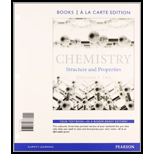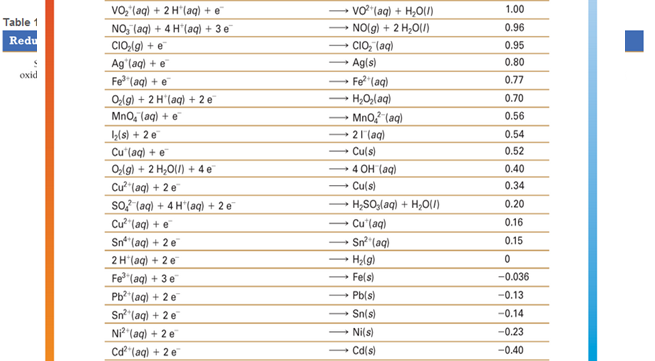
Chemistry: Structures and Properties, Books a la Carte Plus MasteringChemistry with eText -- Access Card Package
1st Edition
ISBN: 9780321974617
Author: Nivaldo J. Tro
Publisher: PEARSON
expand_more
expand_more
format_list_bulleted
Concept explainers
Textbook Question
Chapter 20, Problem 14E
How can Table 19.1 be used to predict whether or not a metal will dissolve in HCl? In HNO3?
be used to predict whether or not a metal will dissolve in HCl? In HNO3?
Expert Solution & Answer
Want to see the full answer?
Check out a sample textbook solution
Students have asked these similar questions
in the scope of the SCH4U course! please show all steps as im still learning how to format my answers in the format given, thank you!
help me solve this HW
Molecules of the form AH2 can exist in two potential geometries: linear or bent. Construct molecular orbital diagrams for linear and bent CH2. Identify the relevant point group, include all of the appropriate symmetry labels and pictures, and fill in the electrons. Which geometry would you predict to be more stable, and why? (Please draw out the diagram and explain)
Chapter 20 Solutions
Chemistry: Structures and Properties, Books a la Carte Plus MasteringChemistry with eText -- Access Card Package
Ch. 20 - Balance the redox reaction equation (occurring in...Ch. 20 - Prob. 2SAQCh. 20 - Prob. 3SAQCh. 20 - Refer to Table 19.1 to determine which statement...Ch. 20 - Prob. 5SAQCh. 20 - The Zn/Zn2+ electrode has a standard electrode...Ch. 20 - Refer to Table 19.1 to calculate G for the...Ch. 20 - A redox reaction has an Ecell=0.56V . What can you...Ch. 20 - Prob. 9SAQCh. 20 - Prob. 10SAQ
Ch. 20 - Prob. 11SAQCh. 20 - Prob. 12SAQCh. 20 - Which reaction occurs at the cathode of an...Ch. 20 - Copper is plated onto the cathode of an...Ch. 20 - Prob. 15SAQCh. 20 - Prob. 1ECh. 20 - Explain the difference between a voltaic (or...Ch. 20 - Prob. 3ECh. 20 - Prob. 4ECh. 20 - Prob. 5ECh. 20 - Prob. 6ECh. 20 - What is the definition of the standard cell...Ch. 20 - Describe the basic features of a cell diagram (or...Ch. 20 - Why do some electrochemical cells employ inert...Ch. 20 - Describe the standard hydrogen electrode (SHE) and...Ch. 20 - How is the cell potential of an electrochemical...Ch. 20 - Prob. 12ECh. 20 - Prob. 13ECh. 20 - How can Table 19.1be used to predict whether or...Ch. 20 - Explain why Ecell , Grxn , and K are all...Ch. 20 - Does a redox reaction with a small equilibrium...Ch. 20 - How does Ecell depend on the concentrations of the...Ch. 20 - Prob. 18ECh. 20 - What is a concentration electrochemical cell?Ch. 20 - What are the anode and cathode reactions in a...Ch. 20 - What are the anode and cathode reactions in a...Ch. 20 - Prob. 22ECh. 20 - What is a fuel cell? What is the most common type...Ch. 20 - The anode of an electrolytic cell must be...Ch. 20 - What species is oxidized, and what species is...Ch. 20 - If an electrolytic cell contains a mixture of...Ch. 20 - Why does the electrolysis of an aqueous sodium...Ch. 20 - What is overvoltage in an electrochemical cell?...Ch. 20 - How is the amount of current flowing through an...Ch. 20 - Prob. 30ECh. 20 - Prob. 31ECh. 20 - Prob. 32ECh. 20 - Balance each redox reaction occurring in acidic...Ch. 20 - Prob. 34ECh. 20 - Balance each redox reaction occurring in acidic...Ch. 20 - Prob. 36ECh. 20 - Prob. 37ECh. 20 - Balance each redox reaction occurring in basic...Ch. 20 - Prob. 39ECh. 20 - Prob. 40ECh. 20 - Calculate the standard cell potential for each of...Ch. 20 - Prob. 42ECh. 20 - Consider the voltaic cell: Determine the direction...Ch. 20 - Prob. 44ECh. 20 - Use line notation to represent each...Ch. 20 - Use line notation to represent each...Ch. 20 - a sketch of the voltaic cell represented by the...Ch. 20 - Prob. 48ECh. 20 - Determine whether or not each redox reaction...Ch. 20 - Prob. 50ECh. 20 - Which metal could you use to reduce Mn2+ ions but...Ch. 20 - Prob. 52ECh. 20 - Prob. 53ECh. 20 - Prob. 54ECh. 20 - Prob. 55ECh. 20 - Prob. 56ECh. 20 - Calculate Ecell for each balanced redox reaction...Ch. 20 - Prob. 58ECh. 20 - Prob. 59ECh. 20 - Which metal is the best reducing agent? Mn Al Ni...Ch. 20 - Use tabulated electrode potentials to calculate...Ch. 20 - Use tabulated electrode potentials to calculate...Ch. 20 - Prob. 63ECh. 20 - Calculate the equilibrium constant for each of the...Ch. 20 - Calculate the equilibrium constant for the...Ch. 20 - Prob. 66ECh. 20 - Calculate Grxn and Ecell for a redox reaction with...Ch. 20 - Prob. 68ECh. 20 - Prob. 69ECh. 20 - Prob. 70ECh. 20 - Prob. 71ECh. 20 - Prob. 72ECh. 20 - Prob. 73ECh. 20 - Prob. 74ECh. 20 - Prob. 75ECh. 20 - Consider the concentration cell: Label the anode...Ch. 20 - Prob. 77ECh. 20 - Prob. 78ECh. 20 - Prob. 79ECh. 20 - Prob. 80ECh. 20 - Refer to the tabulated values of Gf in Appendix...Ch. 20 - Refer to the tabulated values of Gf in Appendix...Ch. 20 - Prob. 83ECh. 20 - Prob. 84ECh. 20 - Prob. 85ECh. 20 - Prob. 86ECh. 20 - Prob. 87ECh. 20 - Which products are obtained in the electrolysis of...Ch. 20 - Write equations for the half-reactions that occur...Ch. 20 - Which products are obtained in the electrolysis of...Ch. 20 - Prob. 91ECh. 20 - Write equations for the half-reactions that occur...Ch. 20 - Prob. 93ECh. 20 - Prob. 94ECh. 20 - Prob. 95ECh. 20 - Silver can be electroplated at the cathode of an...Ch. 20 - A major source of sodium metal is the electrolysis...Ch. 20 - Prob. 98ECh. 20 - Prob. 99ECh. 20 - Prob. 100ECh. 20 - Consider the molecular view of an AL strip and...Ch. 20 - Consider the molecular view of an electrochemical...Ch. 20 - Prob. 103ECh. 20 - Prob. 104ECh. 20 - The cell potential of this electrochemical cell...Ch. 20 - Prob. 106ECh. 20 - Prob. 107ECh. 20 - What voltage can theoretically be achieved in a...Ch. 20 - A battery relies on the oxidation of magnesium and...Ch. 20 - A rechargeable battery is constructed based on a...Ch. 20 - If a water electrolysis cell operates at a current...Ch. 20 - Prob. 112ECh. 20 - Prob. 113ECh. 20 - Prob. 114ECh. 20 - Calculate Grxn and K for each reaction. The...Ch. 20 - Calculate Grxn and K for each reaction. The...Ch. 20 - The molar mass of a metal (M) is 50.9 g/mol; it...Ch. 20 - A metal forms the fluoride MF3. Electrolysis of...Ch. 20 - A sample of impure tin of mass 0.535 g is...Ch. 20 - Prob. 120ECh. 20 - Prob. 121ECh. 20 - A 215 mL sample of a 0.500 M NaCl solution with an...Ch. 20 - Prob. 123ECh. 20 - Prob. 124ECh. 20 - Prob. 125ECh. 20 - Prob. 126ECh. 20 - Prob. 127ECh. 20 - Prob. 128ECh. 20 - Prob. 129ECh. 20 - Three electrolytic cells are connected in a...Ch. 20 - Prob. 131ECh. 20 - Prob. 132ECh. 20 - Prob. 133ECh. 20 - Prob. 134ECh. 20 - Prob. 135E
Knowledge Booster
Learn more about
Need a deep-dive on the concept behind this application? Look no further. Learn more about this topic, chemistry and related others by exploring similar questions and additional content below.Similar questions
- Indicate the variation in conductivity with concentration in solutions of strong electrolytes and weak electrolytes.arrow_forwardThe molar conductivity of a very dilute solution of NaCl has been determined. If it is diluted to one-fourth of the initial concentration, qualitatively explain how the molar conductivity of the new solution will compare with the first.arrow_forwardWhat does the phrase mean, if instead of 1 Faraday of electricity, Q coulombs (Q/F Faradays) pass through?arrow_forward
- What characteristics should an interface that forms an electrode have?arrow_forwardFor a weak acid AcH, calculate the dissociated fraction (alpha), if its concentration is 1.540 mol L-1 and the concentration [H+] is 5.01x10-4 mol L-1.arrow_forwardIf the molar conductivity at infinite dilution of HAC is A0 = 390.5 S cm² mol¹. Calculate the Arrhenius conductivity of a 9.3% by weight solution of HAc with a pH of 3.3. Data: molecular weight of HAC is 60.05 g/mol and the density of the solution is 1 g/cm³.arrow_forward
- If the molar conductivity at infinite dilution of HAC is A0 = 390.5 S cm² mol¹. Calculate the Arrhenius conductivity of a 9.3% by weight solution of HAc with a pH of 3.3. Data: molecular weight of HAC is 60.05 g/mol and the density of the solution is 1 g/cm³.arrow_forwardIf the molar conductivity at infinite dilution of HAC is A0 = 390.5 S cm² mol¹. Calculate the Arrhenius conductivity of a 9.3% by weight solution of HAc with a pH of 3.3. Data: molecular weight of HAC is 60.05 g/mol and the density of the solution is 1 g/cm³.arrow_forwardDetermine the distance between the metal and the OHP layer using the Helm- holtz model when the electrode's differential capacitance is 145 μF cm². DATA: dielectric constant of the medium for the interfacial zone &r= lectric constant of the vacuum &0 = 8.85-10-12 F m-1 = 50, die-arrow_forward
- Describe a sequence of photophysical processes that can be followed by radiation adsorbed by a molecule in the ground state to give rise to phosphorescent emission.arrow_forwardState two similarities between fluorescence and phosphorescence.arrow_forwardState three photophysical processes that can be related to the effects of incident radiation on a molecule in its ground state. Consider that radiation can give rise to fluorescent emission, but not phosphorescent emission.arrow_forward
arrow_back_ios
SEE MORE QUESTIONS
arrow_forward_ios
Recommended textbooks for you
 Chemistry: The Molecular ScienceChemistryISBN:9781285199047Author:John W. Moore, Conrad L. StanitskiPublisher:Cengage Learning
Chemistry: The Molecular ScienceChemistryISBN:9781285199047Author:John W. Moore, Conrad L. StanitskiPublisher:Cengage Learning General Chemistry - Standalone book (MindTap Cour...ChemistryISBN:9781305580343Author:Steven D. Gammon, Ebbing, Darrell Ebbing, Steven D., Darrell; Gammon, Darrell Ebbing; Steven D. Gammon, Darrell D.; Gammon, Ebbing; Steven D. Gammon; DarrellPublisher:Cengage Learning
General Chemistry - Standalone book (MindTap Cour...ChemistryISBN:9781305580343Author:Steven D. Gammon, Ebbing, Darrell Ebbing, Steven D., Darrell; Gammon, Darrell Ebbing; Steven D. Gammon, Darrell D.; Gammon, Ebbing; Steven D. Gammon; DarrellPublisher:Cengage Learning Principles of Modern ChemistryChemistryISBN:9781305079113Author:David W. Oxtoby, H. Pat Gillis, Laurie J. ButlerPublisher:Cengage Learning
Principles of Modern ChemistryChemistryISBN:9781305079113Author:David W. Oxtoby, H. Pat Gillis, Laurie J. ButlerPublisher:Cengage Learning Chemistry & Chemical ReactivityChemistryISBN:9781337399074Author:John C. Kotz, Paul M. Treichel, John Townsend, David TreichelPublisher:Cengage Learning
Chemistry & Chemical ReactivityChemistryISBN:9781337399074Author:John C. Kotz, Paul M. Treichel, John Townsend, David TreichelPublisher:Cengage Learning Chemistry: Principles and ReactionsChemistryISBN:9781305079373Author:William L. Masterton, Cecile N. HurleyPublisher:Cengage Learning
Chemistry: Principles and ReactionsChemistryISBN:9781305079373Author:William L. Masterton, Cecile N. HurleyPublisher:Cengage Learning Introductory Chemistry: A FoundationChemistryISBN:9781337399425Author:Steven S. Zumdahl, Donald J. DeCostePublisher:Cengage Learning
Introductory Chemistry: A FoundationChemistryISBN:9781337399425Author:Steven S. Zumdahl, Donald J. DeCostePublisher:Cengage Learning

Chemistry: The Molecular Science
Chemistry
ISBN:9781285199047
Author:John W. Moore, Conrad L. Stanitski
Publisher:Cengage Learning

General Chemistry - Standalone book (MindTap Cour...
Chemistry
ISBN:9781305580343
Author:Steven D. Gammon, Ebbing, Darrell Ebbing, Steven D., Darrell; Gammon, Darrell Ebbing; Steven D. Gammon, Darrell D.; Gammon, Ebbing; Steven D. Gammon; Darrell
Publisher:Cengage Learning

Principles of Modern Chemistry
Chemistry
ISBN:9781305079113
Author:David W. Oxtoby, H. Pat Gillis, Laurie J. Butler
Publisher:Cengage Learning

Chemistry & Chemical Reactivity
Chemistry
ISBN:9781337399074
Author:John C. Kotz, Paul M. Treichel, John Townsend, David Treichel
Publisher:Cengage Learning

Chemistry: Principles and Reactions
Chemistry
ISBN:9781305079373
Author:William L. Masterton, Cecile N. Hurley
Publisher:Cengage Learning

Introductory Chemistry: A Foundation
Chemistry
ISBN:9781337399425
Author:Steven S. Zumdahl, Donald J. DeCoste
Publisher:Cengage Learning
Electrolysis; Author: Tyler DeWitt;https://www.youtube.com/watch?v=dRtSjJCKkIo;License: Standard YouTube License, CC-BY